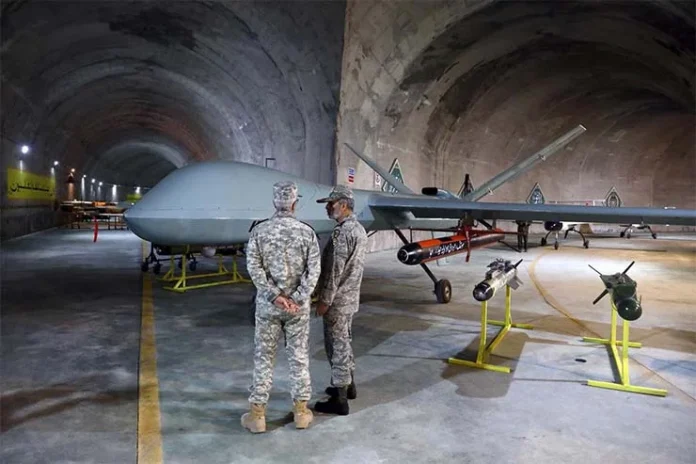Tel Aviv: The cooperation between Russia and Iran in operating armed UAV in Ukraine increases the threat of armed UAV swarms that will be used to attack targets in Israel and some Gulf states. In some cases the Iranian armed UAVs transferred to Russia, have been launched in swarms. In one of the attacks, 28 such UAVs have been used to attack targets. Israel is adapting its multi-tiered air defence system, to deal with swarm of low flying armed drones.
In an article written for the official magazine of the Israeli defence forces (IDF) Maarachot, Yair Ramati, former head of the Israeli missile defence directorate in the Israeli ministry of defence, says that the battlefield in Ukraine proved the Russians the importance of precise attack at ranges of hundreds of kilometres. “To fill this gap quickly, Russia turned to purchasing off-the-shelf products from abroad. The range of possible sources that did not require waiting for production available to the Russians was limited. According to the assessment, they included the first and natural candidate – China, but it seems that she was not interested in putting her name in this type of conflict. The second was Turkey, which combines a business problem by being a NATO member and a supplier of anti-aircraft missiles to Ukraine, and a technical one by the lack of attack products of the type that Russia demanded. Therefore, probably without a choice, Iran was the option.”
Ramati writes that the Iranian supplied Russia with two types of “suicides” UAV – Shahad4 131 and 136 and one for reconnaissance and attack called Mohajer 6. “As could be expected from a country that has almost no air force, Iran developed as a replacement the missile arm of its types and drones. These processes, the seeds of which were planted in the 80s and 90s of the 20th century, gradually began to mature. Step by step, Iran cultivated the necessary infrastructure, while relying on high-quality and educated personnel, initially with liquid ballistic missiles with assistance from North Korea, later – the full aeronautical spectrum of combat systems.”
Eden Kaduri, Liran Antebi and Dr Meir Elran, researchers from the Israeli Institute for National Security Studies (INSS) write that the Iranian UAV program is nevertheless the gravest potential threat to Israel. Iran has shown great boldness in UAV attacks against Middle East targets in recent years. In conclusion, the researchers write that Israel must create a comprehensive strategy to address the growing threat posed by UAVs. Additionally, there must be effective solutions for severe situations that now seem improbable to occur yet present a major risk. One instance is when terrorist organizations fly a small rotary drone against Israel while intoxicated (or from within Israeli territory). In terms of strategy, Israel must also keep creating cutting-edge technologies to address the threat presented by UAVs, expand its intelligence operations in this area, and step up its efforts to collaborate with other nations, including its defence exports in this sector. This danger, which will only get worse in the future, affects more than simply Israel.
An Israeli senior expert in air defence, said that the two Iranian manufacturers of armed and unarmed UAV –Qods and Hesa received in recent months large sums of money for their products used by the Russians in Ukraine. ” This money will help the Iranian companies to develop and manufacture large numbers of advanced armed UAV that will be in use in the hands of Iran’s proxies around the world. This reality emphasizes again the urgent need for close cooperation between Israel and Gulf countries including Saudi Arabia. Such cooperation will be not sharing intelligence but about systems that can counter UAV attacks.”
The expert added that air defence systems can cope with armed UAV swarms but added that the problem is detecting them as they fly very low. The Israeli air force made some changes in its early warning systems. Some are classified but one –deploying large tethered balloons carrying long range radar systems is operational. According to estimates so far Iran supplied 1400 UAV’s to Russia. Intelligence sources say that the Russians have ordered 2400 additional, mostly the armed versions. The money goes to the two manufacturing companies controlled by the Iranian regime. Israeli sources said that the money will be invested in upgrading the armed UAV’s with a focus of greater immunity to GPS interference and improved warheads.
The deals with Russia according to the Israeli defence sources will take the Iranian industry “some big steps” forward as one source put it. Iran understands that its growing arsenal of UAVs including the armed ones is a potential for attacks by “foreign forces”. In August, according to Iran International website operated from London by the Iranian opposition, Tehran exposed an underground military base on the second day of its countrywide drone war exercise. An Iranian announcement about a joint UAV exercise in the participation of Russia, Belarus and Armenia was held in August at the Kashan Air Base, explains the Russian idea to ask Iran for armed UAVs.
The Iranians are actively involved in operating their armed UAVs by the Russians in Ukraine. Earlier this month, ten Iranians training Russian soldiers were reportedly killed in Ukrainian strikes, an Ukrainian official told KAN Israeli news channel. The report comes as American and Ukrainian officials warned that Iranians are training Russians to use Iranian UAVs in Crimea.
Pentagon Press Secretary Brig Gen Pat Ryder stated on November 3 that “Iranians have been on the ground in Ukraine to assist Russia with the drone operations there.” US State Department spokesperson Ned Price stated during a press briefing the same day that the Iranian trainers were operating in Crimea.
Israeli defence sources said that the active involvement of Iranians in operating their UAV in Ukraine will help Iran in developing more advanced versions. The sources added that the Iranian armed UAVs pose a major threat not only to sensitive sites but also to ground forces. “This threat is only starting to develop but armed forces must be ready for it as the armed UAVs will be a major part of any future military confrontation,” one of the sources said. According to Israeli defence sources, the fast growing Iran’s armed UAV capabilities, causes concerns in Gulf countries and some of them have already started negotiations about the purchase of Israel early warning systems.
-The writer is an Israel-based freelance journalist. The views expressed are of the writer and do not necessarily reflect the views of Raksha Anirveda






